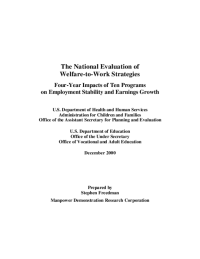Four-Year Impacts of Ten Programs on Employment Stability and Earnings Growth
This paper explores whether programs in the National Evaluation of Welfare-to-Work Strategies (NEWWS) helped welfare recipients attain employment stability and earn more over time. These outcomes (defined in greater detail below) are important prerequisites for achieving long-term self-sufficiency and have served as goals of welfare-to-work programs past and present. The need for programs to promote stable employment and earnings growth has grown stronger since passage of PRWORA, which imposes time limits on most families' eligibility to receive federally-funded welfare benefits. Further, as welfare caseloads continue to fall, administrators and policy makers face the greater challenge of achieving these goals when working with recipients with more serious barriers to employment and at greatest risk of exhausting their eligibility to receive benefits.
To meet the challenges of welfare reform, state and local administrators and policy makers require solid information on the types of welfare-to-work programs that help people maintain steady employment over several years and earn more over time. This paper helps address this need by describing useful ways of measuring employment stability and earnings growth and by analyzing the effects of ten welfare-to-work programs on these measures over a four-year follow-up period. The paper also describes ways of measuring unstable or sporadic employment and estimates program effects on these measures. Welfare recipients who work sporadically may benefit from additional pre- or post-employment services or financial incentives provided by welfare agencies.
Results are presented for ten programs operated in six sites: Atlanta, Georgia; Columbus, Ohio; Detroit and Grand Rapids, Michigan; Portland, Oregon; and Riverside, California. Welfare recipients who enrolled in these programs were required to participate in employment-related activities and could incur financial sanctions (reductions in welfare benefits) for noncompliance.







